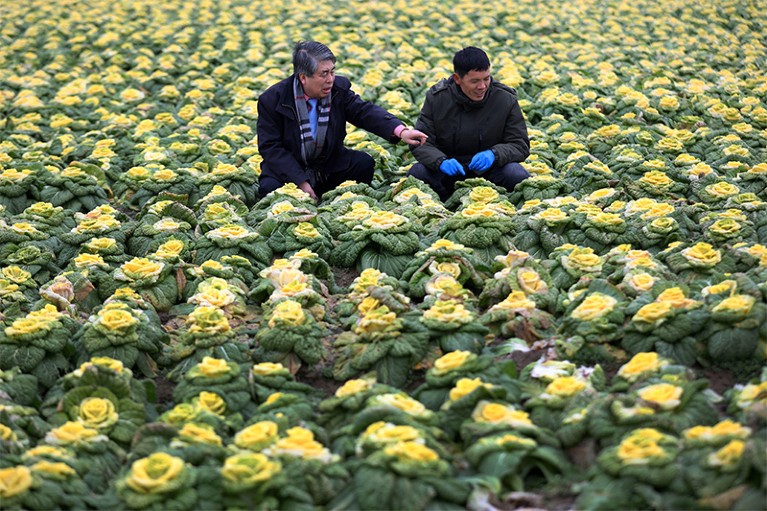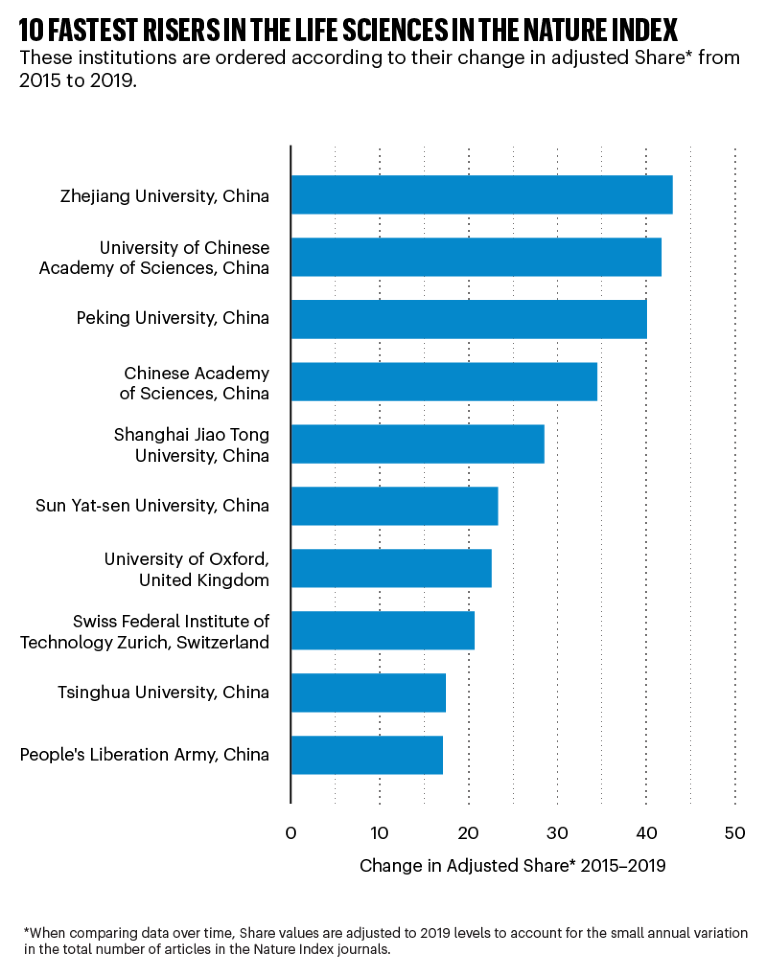
Rose-like Chinese cabbage, developed by Hou Xilin at the College of Horticulture, Nanjing Agricultural University.Credit: Imaginechina Limited/Alamy
Zhejiang University (ZJU) in Hangzhou, China, is the fastest-rising institution in life-sciences research in the Nature Index 2020 Annual Tables.
Its change in adjusted Share from 2015 to 2019 was 42.94, representing a 158.1% increase over 4 years. (When comparing data over time, Share values are adjusted to 2019 levels to account for the small annual variation in the total number of articles in the Nature Index journals. The Nature Index is one indicator of institutional research performance. See Editor’s note below.)
Chinese institutions represent eight of the ten fastest-rising institutions in the discipline, and the University of Oxford, UK, and the Swiss Federal Institute of Technology Zurich in Switzerland are 7th and 8th, respectively (see Graphic). See the 2020 Annual Tables Top 100 institutions for life sciences for 2019.

Source: Nature Index
Here is a selection of institutions from the top 30 of the Nature Index 2020 Annual Tables — rising stars in life-sciences research.
Zhejiang University, China
Change in adjusted Share (2015–19): 42.94; % change: 158.1%; Place: 1st
Located in Hangzhou, the capital of China’s Zhejiang province in the country’s east, Zhejiang University is part of the Chinese government’s Double First Class Plan, which aims to develop several world-class universities by 2050. Since 2015, its output in the life sciences has more than doubled, making it one of the fastest rising institutions in the discipline.
Nature Index 2020 Annual Tables
The 120-year-old university has established 17 interdisciplinary alliances to find solutions to global challenges, from improving crops, to developing minimally invasive medical devices. For example, its Antibody-Based Novel Drug Research and Industrialization Alliance has partnered with Hisun Pharmaceutical, Zhejiang Medicine and Newsummit Biopharma to develop biopharmaceutical drugs.
Among the research published by Zhejiang scientists in 2019 was a method for regenerating tooth enamel (Science Advances), the discovery of a tumour-suppressing compound in broccoli (Science), and the development of ‘bio glue’ that can rapidly repair heart wounds (Nature Communications).
Fudan University, China
Change in adjusted Share (2015–19): 15.41; % change: 36.0%; Place: 12th
The Shanghai-based Fudan University was the first privately launched higher-education institution in China, established in 1905. In the 1940s, it became a public university, and a decade later, became a comprehensive university focused on the humanities, social sciences and basic research in the natural sciences.
In several college rankings, including the Times Higher Education and Quacquarelli Symonds tables, Fudan is considered among the top 5 universities in China, alongside Peking University in Beijing, Zhejiang University in Hangzhou, Tsinghua University in Beijing, and the University of Science and Technology of China in Hefei. Its merger with the Shanghai Medical University in 2000 strengthened Fudan’s national standing in life-sciences research.
In 2019, Fudan had enrolled 13,623 undergraduate and 22,610 graduate students. Its 3,110 faculty includes 47 members of the Chinese Academy of Sciences and Chinese Academy of Engineering and 119 recipients of the Distinguished Young Scientist award from the National Natural Science Foundation of China.
Fudan hosts several State Key Labs — facilities that receive funding and administrative support from the Chinese government — including the State Key Lab of Genetic Engineering, a leading player in China’s life-sciences research.
Nanjing Agricultural University, China
Change in adjusted Share (2015–19): 14.79; % change: 280.1%; Place: 15th
Based in Nanjing, the capital city of the wealthy eastern Chinese province of Jiangsu, Nanjing Agricultural University (NJAU) was established in 1952 as a conglomeration of agriculture departments from Nanjing University, the University of Nanking and Zhejiang University. In 1963, it was classified by the Chinese government as one of the two national key agricultural universities (the other is Shenyang Agricultural University in the city of Shenyang in the country’s northeast).
In 2019, NJAU had 17,000 undergraduate and 11,000 graduate students, and 2,700 faculty members, including two members of the Chinese Academy of Engineering. Hosting the State Key Laboratory of Crop Genetics and Germplasm Enhancement and more than 60 national research centres in agriculture and related disciplines, NJAU has received 2.6 billion yuan (US$366 million) in research grants.
NJAU hosts four national key disciplines, including crop science, agricultural resources and environment, and plant protection, which have been recognized by China’s Ministry of Education. Both of its agricultural science and botany/zoology disciplines were ranked among the world’s top 0.1%, according to Essential Science Indicators rankings, developed by Clarivate.
University of Copenhagen, Denmark
Change in adjusted Share (2015–19): 14.6; % change: 23.6%; Place: 18th
Founded in 1479 as a studium generale (medieval university), the University of Copenhagen (UCPH) is the second-oldest institution for higher education in Scandinavia, after Uppsala University, which was established in 1477 in Sweden. With almost 38,000 students and almost 5,000 research faculty, UCPH is the largest university in Denmark.
Known for its biomedical research, the university’s long-standing collaboration with the Beijing Genomics Institute (or BGI Group), headquartered in Shenzhen, China — which is among China's largest commercial providers of genomic sequencing and analysis — is one of the most productive corporate–academic partnerships in the Nature Index. Notable examples of their work include meta-genomic sequencing of human gut bacteria and piecing together ancient DNA.
The UCPH Faculty of Health & Medical Sciences, which encompasses 5 schools, 13 departments and 3 hospitals, is home to the LEO Foundation Skin Immunology Research Center, launched in 2018, which aims to improve the prevention and treatment of skin diseases such as psoriasis and melanoma.
University of Amsterdam, the Netherlands
Change in adjusted Share (2015–19): 11.95; % change: 62.0%; Place: 26th
With 30,000 students, 6,000 staff members, and 3,000 PhD candidates, the University of Amsterdam (UvA) is the largest university in the Netherlands, and dates back to 1632. Its Faculty of Science encompasses eight research institutes, focusing on astronomy, computing science, biology, logic, physics, mathematics, life sciences and chemistry.
The Swammerdam Institute for Life Sciences, established in 2000, is one of the largest institutes in the UvA Faculty of Science, and brings together 240 researchers in areas such as cell and systems biology, neuroscience and ‘green life sciences’, which aims to understand how plants deal with certain stresses, insects, microbes and other organisms, and how they diversified during evolution.
In a February 2020 Science Advances paper, UvA researchers examined the effects of atmospheric levels of carbon dioxide on the common cyanobacterium Microcystis, which is responsible for many toxic blooms on lakes. They found that the bacteria readily adapted to take up more CO2, which the team suggests could lead to increased blooms on lakes as atmospheric CO2 levels rise.

 Show of strength
Show of strength
 Fastest movers since 2015
Fastest movers since 2015
 Ten countries with high-performing hubs of natural-sciences research
Ten countries with high-performing hubs of natural-sciences research
 Leading research institutions 2020
Leading research institutions 2020
 The ten leading countries in natural-sciences research
The ten leading countries in natural-sciences research
 Fast-rising research institutions 2020
Fast-rising research institutions 2020
 Fast-rising academic institutions 2020
Fast-rising academic institutions 2020
 Rising stars in chemistry 2020
Rising stars in chemistry 2020
 Rising stars in physical sciences 2020
Rising stars in physical sciences 2020
 Rising stars in Earth and environmental sciences 2020
Rising stars in Earth and environmental sciences 2020








